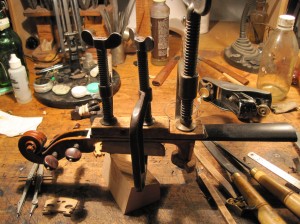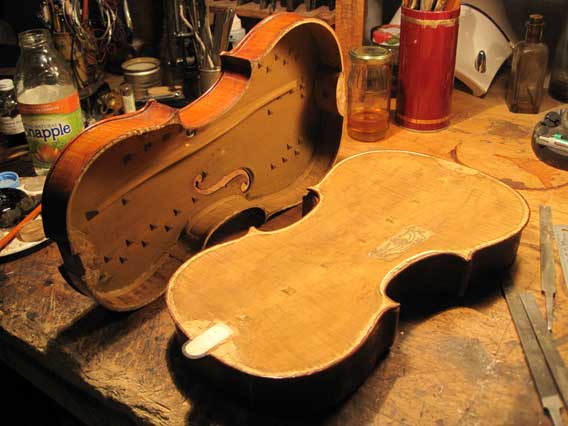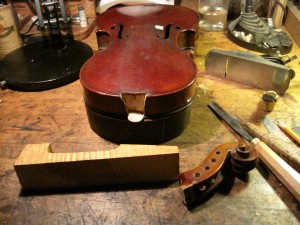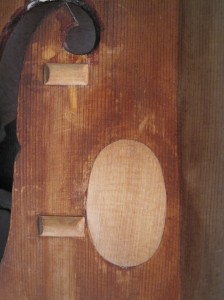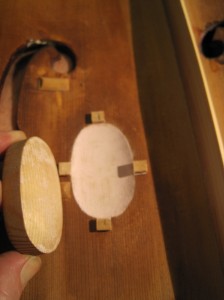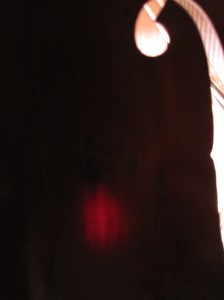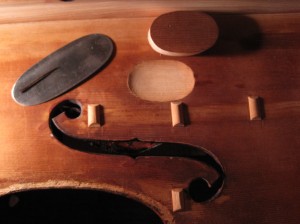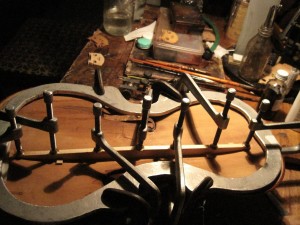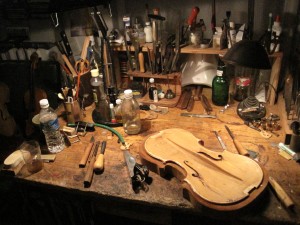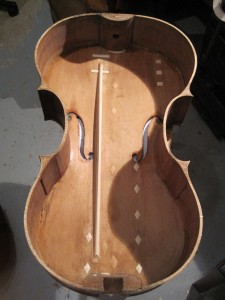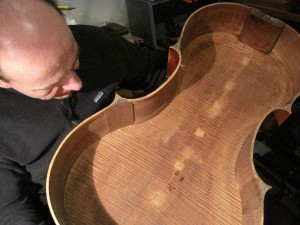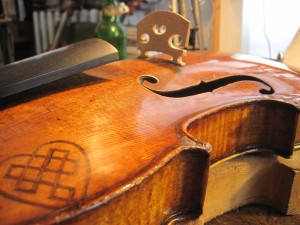 C J – the principal violist of the Philly O will be playing the Walton concerto in front of the orchestra. In preparing for it he asked me to do all I could to make it look and sound its best.Among other things, we decided to try a new higher bridge. You don’t simply work on C J ‘s viola – you collaborate . He has very strong ideas – and I always like the urgency and intensity that he brings to it. I find myself constantly learning by this kind of interaction with players – each player and instrument is different and success requires different approaches all the time
C J – the principal violist of the Philly O will be playing the Walton concerto in front of the orchestra. In preparing for it he asked me to do all I could to make it look and sound its best.Among other things, we decided to try a new higher bridge. You don’t simply work on C J ‘s viola – you collaborate . He has very strong ideas – and I always like the urgency and intensity that he brings to it. I find myself constantly learning by this kind of interaction with players – each player and instrument is different and success requires different approaches all the time 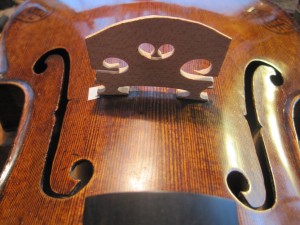
Category Archives: Repairs
Lorne Munroe’s second cello suffers a fall
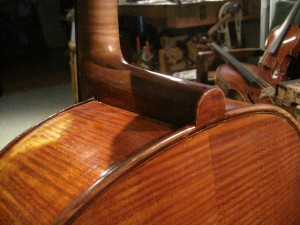
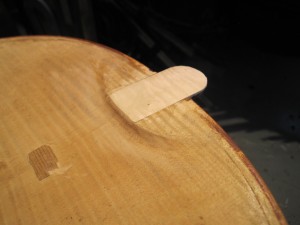 This cello belongs to the great Philadelphia cellist Lorne Munroe. It was made for him by Thomas Elmer in Philadelphia in 1960. Unfortunately it suffered a fall and the neck pulled out at the button and to make things more difficult the piece of the back known as the button – which is glued to the neck- has separated at the purfling and stayed attached to the neck stock. In order to do this repair properly the back must come off and the button must be carefully removed from the neck and reglued to the back. Then the break will be discretely reinforced with new wood spanning the break.The back then is glued back on and the button area is ready for varnish touch up that will make the break invisible – which should make you think twice and look very close when buying an old instrument! Lastly, the neck is reset, the varnish is restored and to the untrained eye nothing has happened.
This cello belongs to the great Philadelphia cellist Lorne Munroe. It was made for him by Thomas Elmer in Philadelphia in 1960. Unfortunately it suffered a fall and the neck pulled out at the button and to make things more difficult the piece of the back known as the button – which is glued to the neck- has separated at the purfling and stayed attached to the neck stock. In order to do this repair properly the back must come off and the button must be carefully removed from the neck and reglued to the back. Then the break will be discretely reinforced with new wood spanning the break.The back then is glued back on and the button area is ready for varnish touch up that will make the break invisible – which should make you think twice and look very close when buying an old instrument! Lastly, the neck is reset, the varnish is restored and to the untrained eye nothing has happened.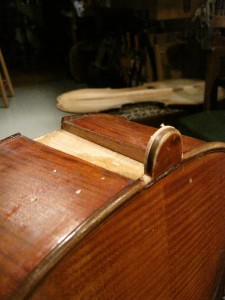
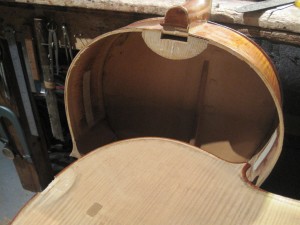
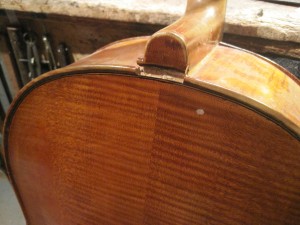
A nice 1780 Chappuy violin suffers a dramatic injury
[nggallery id=5]
The neck has come violently out of the body of this nice, old French violin due to a fall. The back will have to come off ,the button re-glued and then patched. Then the neck will be reset. It will no doubt re-emerge as a fine violin. Hopefully there will be no trace of the damage- except maybe to the trained eye.
The back has now been taken off and the broken button re-glued to the back(it was still attached to the neck stock from the neck coming out suddenly). Then a patch is fit spanning the break to strengthen the area to hold the tension on the neck set. This patch will be hidden by the ebony ring on the neck stock.
Didier Nicolas violin c. 1825 needs a neck graft
This fine French instrument still has its original neck, but sadly it doesn’t conform to the measurements of todays standards. Its neck length is too short and its height out over the top of the violin is much too low. There is little else one can do but graft the scroll onto a new new block. Done carefully it is barely noticeable. The first step is to remove the neck from the corpus of the violin. You CAREFULLY saw just to the neck side of the button. I will update this process as the work progresses
Nice German cello needs a soundpost patch
This cello had an ill fitting soundpost that was not in the right location.Therefore it didn’t support the top against the tremendous strain of the string tension down on the treble foot of the bridge and eventually the soft spruce top developed a crack. In order to repair this crack you need to first glue the crack and then fit an inlaid patch into the top forming a “landing pad” of new wood for the new soundpost. Without this new patch the immense pressure down on the post post would simply force the crack open again. The first step is to carve out the spruce at the post area. At its deepest point the top is left 1 mm thick. The photo shows light from behind the cello streaming through the patch area. In order for the patch to the completely fit the scooped out shape of the top you need to use chalk as a transfer material. The surfaces must fit exactly so that no distortion of the top will be visible on the outside of the cello. If the patch doesn’t fit well the top will show the imprint of the patch. The chalk must thoroughly cover the patch before it is glued in. Once glued in, it is trimmed and carefully scraped to blend with the contour of the top. Notice that the dark, winter grains of the patch are at a slight diagonal to the grains of the top. This provides added strength by spanning the crack, rather than the grains of the patch running similarly with the top, with the chance that the patch could both soft summer grains over the crack with the soundpost exerting its pressure there and re-opening the crack
Late night bass bar
A beautiful,small English viola c. 1800 by William Forster. The bass bar is crucial to the lower registers resonance. It has two functions. It helps support the top against downward string tension exerted through the bridge .It also acts as a conduit through which the vibrations are spread out over the whole spruce top. The soft spruce of the top flexes widely giving the lower register its “growl”. This viola is a higher arched model which means the bar can and should be slighter since the higher arching needs less support. Few bars are correct in terms of placement and heft. I make sure all my instruments have a proper bass bar.
About to put in a new bass bar in a 1971 Celestino Farotto viola
Major repairs to a Vavra cello of Prague
This cello needs a soundpost patch in the back among other things. First the top needs to come off to repair and reinforce several cracks. To get to one of the larger cracks the bass bar must come out. Then a new one is put in after these repairs are done. In the view of the top the long ,horizontal studs are fit with tension to correct sunken arching in the lower bass section of the top.Once the top is back on the ribs the back will come off and a mold will be made to provide support for gluing in the patch. Stay tuned -its under way.
